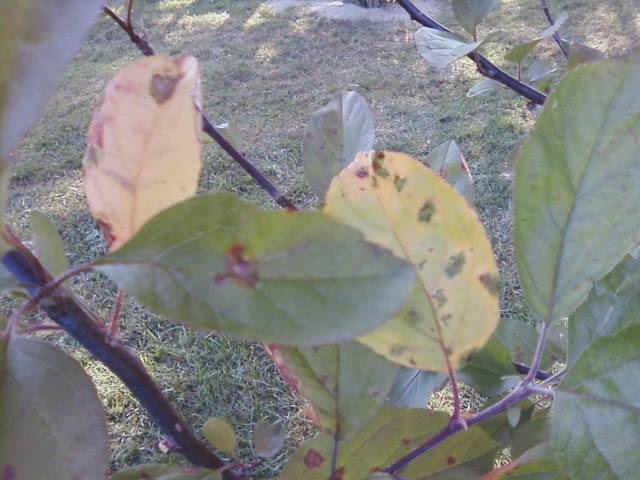Question
 Spotty Leaves on Craba
Spotty Leaves on Craba
My husband & I planted a flowering crabapple tree (Robinson) this spring. It is about 8 - 9 feet tall & looked beautiful when we brought it home with all the pink flowers. Now the tree keeps getting yellow spotty leaves on it & they fall off. Some of the green leaves are spotty also. The spots are brown with green around them. We did discover that a rabbit started eating the bottom part of the bark, but we covered that up & put chicken wire around the tree limb to keep them little critter away from it. What is your expert option on what could be causing my problem leaves & what I can I do to help it out? I am hoping we can save it because it is a beautiful shaped tree & had a hard time finding one that looks this beautiful. Please help!!!
AnswerLooks like one of the leaf spot fungi.
A common reaction is to run for the sprayer and quickly apply a chemical to the ailing tree. Usually this is a waste of time and money. The majority of trees and shrubs have learned to live with leaf spot diseases. Even severe defoliation will not cause the death of an otherwise healthy tree. Also, the by the time symptoms of leaf spot are obvious, it is often too late to apply a chemical for control.
Trees which are subject to serious injury when attacked by a leaf spot fungus are those trees which are under stress. This might include recently transplanted trees, trees growing under drought conditions or trees weakened by continuous insect attack The additional stress of a leaf spot disease on an already weak tree may cause permanent injury or death. In such cases, chemical control of leaf spots is often recommended.
In order to be effective, the proper fungicide must be applied as a protectant before the fungus spore is disseminated to the leaf. Most leaf spot fungi infect trees early in the spring just as the leaves are unfolding. Successful control usually requires two to three spray applications. In general, the first spray is applied at bud break and the second seven to 14 days after that. A third spray might be necessary, particularly during rainy periods. The more rain the more frequent the spray applications must be.
Some recommended fungicides for control of leaf spot diseases are: chlorothalonil (Daconil 2787 or Bravo), fixed coppers, mancozeb, maneb and zineb. Check with your local garden type store for these products and follow the instructions on the product. IF used now they will not control the spots on the leaves but if used in the spring they prevent leaf spots from forming.
Since many of the leaf spot fungi overwinter on fallen leaves, one cultural method of reducing the severity of leaf spots is to rake and destroy all old leaves under the tree. This will reduce the number of fungal spores available to infect developing leaves in the spring. Disposing of old leaves is not likely to be effective if leaves from the same species of tree or shrub in your area are not destroyed because spores of most of the causal fungi can be wind disseminated for long distances.
I would recommend that you destroy all leaves that fall and also fertilize with 10-10-10 fertilizer this Fall at the rate of 1 lb of fertilizer per inch of trunk diameter scattered around the tree and watered in good. Apply just before a rain storm and you will not need to water it in.






